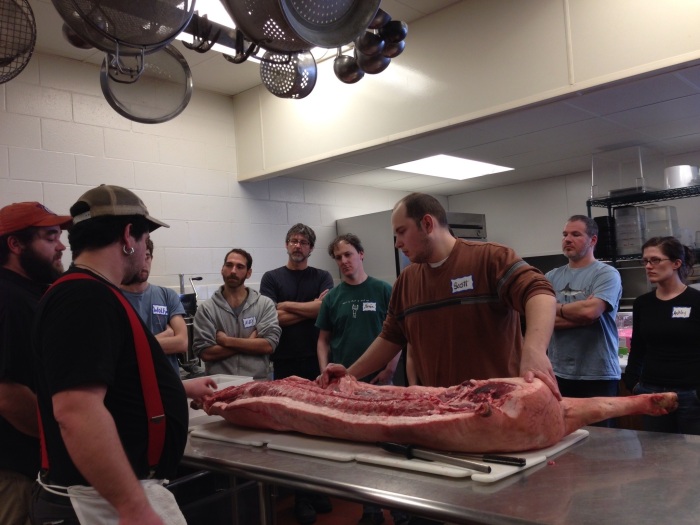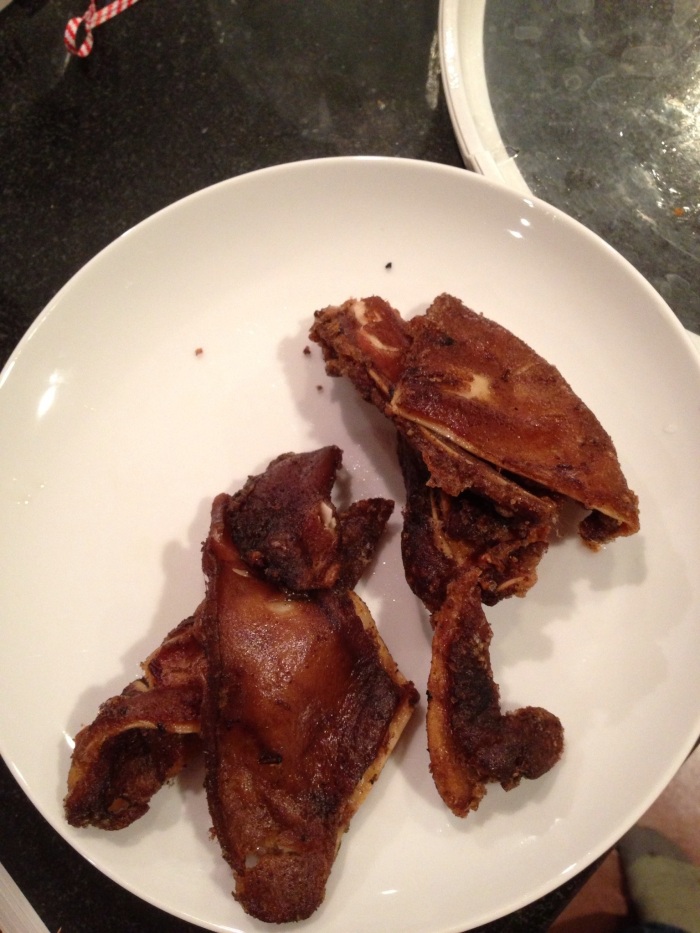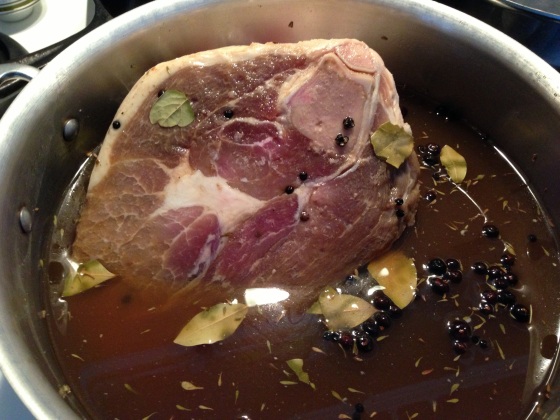Search Results
Pork, Pork and More Pork (Plus Recipes)

Butcher case at Rosemont Market’s Brighton Avenue location, where local lard is touted as the new olive oil. Pork there is from Milkweed Farm right here in Brunswick.
I’m totally spent, after appearing on local TV for the first time, and banging out a cover story for The Portland Phoenix’s pig issue, plus my side column take on Jews and pork. I attended a whole hog butchery workshop (lung was delicious, spleen was gross) and have tracked down numerous chefs, pig farmers and butchers. I remain indebted to Oregon for teaching me how to cure my own guanciale and to seek out meat CSAs and heritage Red Wattle hogs. Now, for some recipes (previously discussed on our latest WBOR radio show on food waste).

Breaking down half a hog in the butchery and curing workshop organized by Giant’s Belly Farm in Greene, Resilient Roots and the Local Sprouts Cooperative.
First, pig ears, normally considered dog food/dog chew toy. Perhaps they should stay that way. I’m all for crispy pig ears at restaurants, but I found them a bit gross and not worth the effort to do at home. I worried about ear wax and hating shaving the ears of hair. For a recipe, I consulted the trusted Michael Ruhlman, a charcuterie guru with a new book out (with co-author chef Brian Polcyn, whom I interviewed) on the porky art of Italian dry-cured Salumi. He recommended prepping pig ears confit-style.
So I rubbed the ears with salt, pepper, garlic and Chinese five spice powder and let them cure overnight (well, ok, they were left in the fridge for a few nights). I was thinking crispy pig ear banh mi. That never happened. I confited them in a super-low oven in grapeseed oil (didn’t have lard). But when I tried to fry them up, they were chewy and gummy and not that crisp. I now see I ignored Ruhlman’s advice to roast them, weighed down between pieces of parchment in a 425 to 450˚ oven. My bad. I missed his note that “a serious issue with frying is that water remaining in the skin can cause them to pop and splatter in hot fat.” Splatter they did.
The pork roast, really an uncured bone-in ham, recipe I tried from Tamar Adler‘s An Everlasting Meal: Cooking with Economy and Grace proved far more satisfying. I got to taste a little roasted bone marrow, which tasted just like that fancy restaurant appetizer. The next day, I made a good ole New England pot of baked beans, flavored with the bone and pork scraps, inspired by a recipe in a recipe from the revamped classic Cooking Down East. Here’s Adler’s recipe…you definitely want to try to brine the ham first, to tenderize the dense muscle. I added molasses and liquid smoke to the brine, to make the meat, well, more ham-like.

The lovely bone-in ham roast (see that yummy bit of marrow) from a Red Wattle hog from Squire Tarbox Farm on Westport Island.
Meat brine (from Tamar Adler’s An Everlasting Meal; roast follows)
1/4 cup salt
1/2 tablespoon sugar (I used molasses too)
water
2 bay leaves
2 whole dried chiles
1 teaspoon juniper berries
4 sprigs thyme
1 teaspoon peppercorns
Combine the salt and sugar over low heat with 1/4 cup water. As soon as the salt and sugar have dissolved, take it off the heat. In the container in which you’re going to brine the pork leg roast, combine everything with a few ice cubes. Mix it all well. Once it is cool, add the meat and water to cover. Brine, before meat is added, stays good forever.
Pork roast
Brine a three-pound pork leg roast (preferably bone-in for flavor) overnight in the refrigerator. Cover the meat with a plate that fits inside the container and weigh it down so that it doesn’t float. Heat the oven to 375 degrees. Remove the pork from the brine and pat it dry. Heat a cast-iron pan or heavy-bottomed pot over medium heat and add 1 tablespoon olive oil. Brown each side of the meat over medium-high heat. Let each side turn caramel brown. This will take 10 to 15 minutes.
Once the pork is browned, put the pan or pot directly in the oven. Cook the meat, untouched, until it’s medium-rare. In an oven, this will take about 20 minutes per pound. Pork will need an internal temperature of 165 degrees when you pull it out of the oven, and will go on cooking once you remove it. Err on the side of under-cooking the meat. Check it with a meat thermometer at its thickest part until you get good at telling doneness by pressing on the meat.
Remove the meat from the pan and let it sit on a cutting board. It needs to rest for at least 20 minutes. Sliced earlier, the outside of the pork may taste salty; if there is still a bone in the cut, the meat along it will still be bloody.
Slice the meat thinly with a sharp knife. If you can avoid it, leave the serrated knife for bread and use the sharpest straight blade you have.
Serve with a big green salad.

Hog butchery workshop in South Portland (notice James Beard Award winning chef Rob Evans of Duckfat in the audience!)
The Banh Mi of Our Dreams: Meatballs are Hot

Banh Mi with meatballs, and Spaghetti and Meatballs All'Amatriciana, both from the January issue of Bon Appetit.
When will I learn not to make such a potschke when I’m rushing out to a potluck. But it’s always fun to experiment when you have an audience of food lovers that includes more folks than just your husband. So for the Slow Food Corvallis annual potluck, I decided to make the Pork Meatball Banh Mi, that hybrid Vietnamese-French creation that had been calling to me from the meatball special issue of Bon Appetit. There’s something about these umami-packed sandwiches that I always crave. Is it the mushroom or liver pate slathered on the baguette? Or the Sriracha-accented mayo? Or the quick-pickled daikon and radish slivers? None of these parts on their own are that special. But together they create a truly memorable culinary creation. Let’s just say that Baguette is my favorite, not to mention the cheapest, place to eat in town.
I wasn’t excited to make another porky dish, but these meatballs were ethereal. Seasoned with basil, chopped lemongrass (my addition), Sriracha chile sauce and a dash of fish sauce, they were like the most succulent dumpling filling. I also happened to make them with special hazelnut-finished Red Wattle pork from Heritage Farms Northwest, which I ordered through the new online farmer’s market, Corvallis Local Foods. They are pretty adorable, happy pigs…and the adults can weigh up to a ton! We had this rare pork at a Slow Food dinner where we compared it to a more conventional breed.
As a vegetarian option, I also made this curried wild mushroom pate for the banh mi, with shiitakes and velvety delicate winter chanterelles (who knew they grew all winter?) also ordered through Corvallis Local Foods. Other dishes at the potluck last night included a lush truffled potato gratin, a Moroccan lamb and pumpkin tagine, and brie baked in homemade, extra yolky brioche. For dessert, we feasted on some ethereal homemade Fig Newtons, baked with locally wheat from Harrisburg, that were infinitely better than the Nabisco ones. It was great to again meet Linda Ziedrich, the author of inspiring cookbooks on pickling and jamming, there, though I’m not sure what she made. We’ve had her call into the KBOO show, and I ran her membrillo recipe with my quince article. Dan was delighted that Intaba sent her excellent (and I think gluten-free?) spinach and meat lasagna home with us, so that was dinner tonight. When a bunch of foodies gather, that’s one potluck where you know you’ll eat well.
BaltiPorkagain: D.I.Y. Bacon and Pancetta
First, I apologize to my readers for not blogging more frequently. I’ve snapped the photos and written countless blog posts in my head that will be composed once this term ends. Somehow, amid this hiatus, more than three times as many readers clicked to my blog yesterday. Crazy how this little piece of Internet real estate works.
My greatest cooking adventure of late has been to try my hand at curing pork belly, with the help of Chef Intaba. I know it’s almost cliched for a foodie to jump on the pork train these days, but it’s seems to be the most available local, sustainably-sourced meat these days. Plus, Intaba ordered half a pig she was willing to share (now I also have a rack of spare-ribs in the freezer, to be braised in some sweet Chinese style).
Curing the bacon, with a slather of maple syrup, kosher salt and curing salt, was uncomplicated. It’s ready to cook after a week curing in the fridge, but we finished it off first in Intaba’s smoker. We’ve enjoyed the salty-sweet, if not slightly tough flesh, with eggs and toast and in own Thanksgiving sauerkraut. Oh, and in some the jury’s-still-out chocolate chip-bacon-hazelnut cookies. I hope to finish it up in David Chang’s Fuji Apple Salad: Kimchi, Smoked Jowl & Maple Labne recipe.
Let’s just say the pancetta didn’t go as well. The week-long curing process, with its rosemary-black peppercorn-juniper rub, is the same as with bacon. But while you don’t smoke pancetta, you do hang it to age for an additional two weeks. That’s where the complications come in. Perhaps our basement didn’t stay at the required 60 degrees (now I wish I had cured it in the garage, even if the colder temp meant it took longer). But the skin started to grow a white mold, so I cut it down a few days early. It didn’t smell rotten but something wasn’t quite right. Our too-thick pork belly wasn’t “completely firm but pliable like leather,” as the CHOW recipe recommends. We didn’t trim the fat evenly enough. So the exterior was hard as jerky but parts of the interior meat were still soft. I still cooked a bit up. Now Intaba is smoking the rest to remedy the situation. I’ll make bacon again, any day. But when it comes to pancetta, for now I’ll stick to buying the imported stuff or at least professionally-made stuff. Or at least consult the charcuterie bible before my next attempt.
Speaking of pork, I ordered some smoked ham slices and Italian sausage from red wattle heritage pigs through last week’s test run of Corvallis Local Foods. This brilliant new site is an online farmers market, where you can electronically order produce and meat from a dozen local vendors. Then you get your pre-paid order at a weekly pick-up at a local farm stand (the Brooklane/La Mancha Orchards of Anita Azarenko of OSU: they have the best organic Goldrush apples!). My friend George is heading it up. And busy Amy of Our Home Works markets and develops the software, which started with Eugene Local Foods and is rolling out to other locations, including Santa Cruz. Contact them to get such a local foods online marketplace in your community. And I promise we’ll back off the pork soon.









